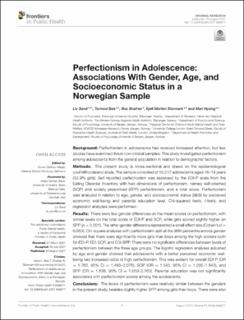| dc.description.abstract | Background: Perfectionism in adolescence has received increased attention, but few studies have examined this in non-clinical samples. This study investigated perfectionism among adolescents from the general population in relation to demographic factors.
Methods: The present study is cross-sectional and draws on the epidemiological youth@hordaland study. The sample consisted of 10.217 adolescents aged 16–19 years (52.9% girls). Self-reported perfectionism was assessed by the EDI-P scale from the Eating Disorder Inventory with two dimensions of perfectionism, namely self-oriented (SOP) and socially prescribed (SPP) perfectionism, and a total score. Perfectionism was analyzed in relation to age, gender, and socioeconomic status (SES) by perceived economic well-being and parental education level. Chi-squared tests, t-tests, and regression analyses were performed.
Results: There were few gender differences on the mean scores on perfectionism, with similar levels on the total score of EDI-P and SOP, while girls scored slightly higher on SPP (p < 0.001). The latter gender difference represented a small effect size (Cohen's d = 0.053). Chi-square analyses with perfectionism split at the 90th percentile across gender showed that there were significantly more girls than boys among the high scorers both for EDI-P, EDI-SOP, and EDI-SPP. There were no significant differences between levels of perfectionism between the three age groups. The logistic regression analyses adjusted by age and gender showed that adolescents with a better perceived economic well-being had increased odds of high perfectionism. This was evident for overall EDI-P (OR = 1.760, 95% CI = 1.493–2.076), SOP (OR = 1.543, 95% CI = 1.292–1.843), and SPP (OR = 1.836, 95% CI = 1.559–2.163). Parental education was not significantly associated with perfectionism scores among the adolescents.
Conclusions: The levels of perfectionism were relatively similar between the genders in the present study, besides slightly higher SPP among girls than boys. There were also significantly more girls than boys among the high scorers on overall perfectionism, SOP, and SPP, respectively. High perfectionism was related to SES for perceived economic well-being, but not for parental education level. Implications for further research and clinical interventions were suggested. | en_US |

